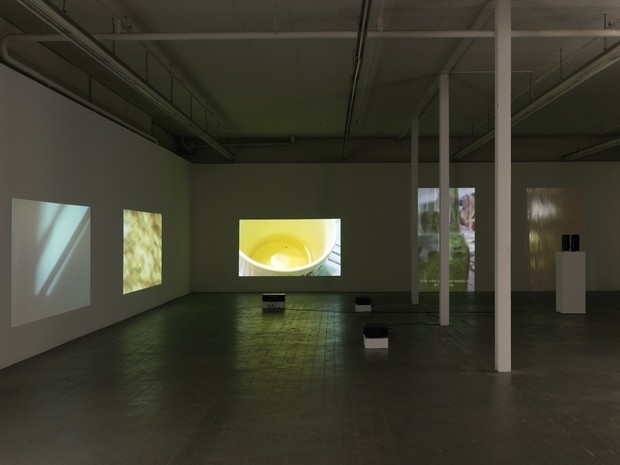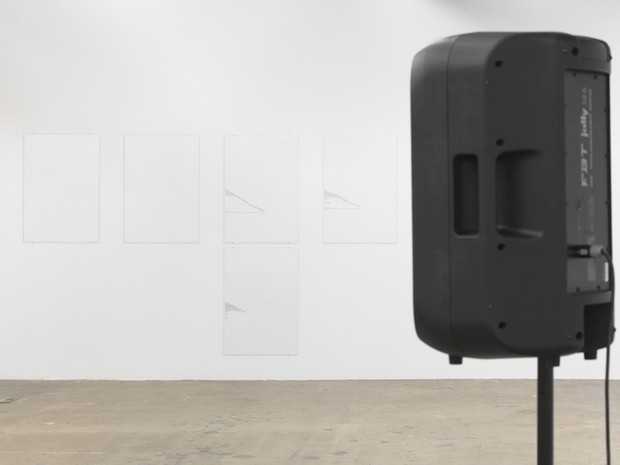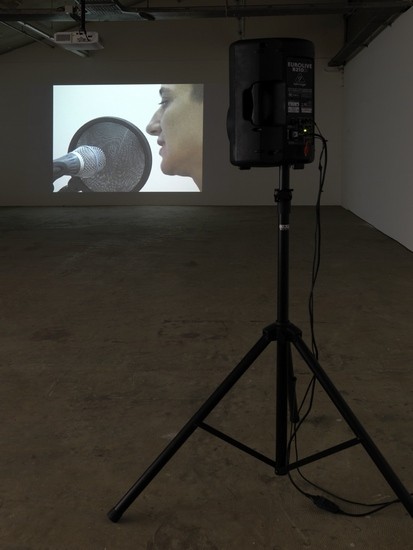Itziar Okariz
31 Mar - 16 Jul 2017

Itziar Okariz, Video Notes 2017, Installationsansicht Kunsthaus Baselland 2017. Foto: Serge Hasenböhler

Itziar Okariz, Dream Diary: From November 22, 2016 to January 11, 2017, Installationsansicht Kunsthaus Baselland, 2017, Foto: Serge Hasenböhler

Itziar Okariz, How d’ye do?, 2010, Installationsansicht Kunsthaus Baselland, 2017, Foto: Serge Hasenböhler

Itziar Okariz, Irrintzi Repetition (Guggenheim Museum Biblao), 2007, Installationsansicht Kunsthaus Baselland 2017. Foto: Serge Hasenböhler
ITZIAR OKARIZ
31 March – 16 July 2017
In cooperation with CA2M. Centro de Arte Dos de Mayo, Madrid, and Tabakalera. Centro Internacional de Cultura Contemporánea, San Sebastián
This exhibition by Itziar Okariz (b. 1965, Spain, lives in Bilbao and Madrid) allows an over-view of the Basque performance artist’s extensive work. Okariz has long been among the most important voices within the international performance scene. Finding the construction of identity is central to her practice. Growing from gender discussions – particularly those of the 1990s – a description of her work in terms of gender alone, however, does it a disservice. How language is dealt with and the possibility of shifting meaning through language are key to her current work in particular. Words and phrases are challenged using fragments, repeti-tion, elisions and new combinations, tested for the possibility of creating new semantic connections. In this, the connection of language and body and the possibility of communi-cating language in space are fundamental.
Directly in the first exhibition space Okariz presents, amongst other works, the sound instal-lation Applause, which relates to a performance at the Guggenheim Museum Bilbao on the 16th October 2007. Visitors can activate the installation themselves using an ‘on’ switch. At this a recording rings out of a slow, regular handclap which the artist recorded, directed towards visitors. Initially it is the clap of a single person, the rhythm intensifying with the collaboration of the people present at the performance location, becoming a louder, consol-idated sound. Like an answer, the guests share the artist’s clapping rhythm for a certain period until the moment in which Itziar Okariz herself changes it and ultimately finishes. In-dependent from its given place and the people present there, this dialogic performance as-sumes the particular form and intensity of the interaction.
Across from this are five video projections from a larger series, which at first appear to be abstract and are difficult to identify. They accord with the artist’s fixing everyday phenome-na with her camera. These are recordings such as morning light entering a space, reflec-tions in a teacup or on falling water, or the structure of a kitchen floor. The titles underline the character of this special kind of video diary that Okariz continually practices and with which she approaches her surroundings from different perspectives – at once fragmentary and narrative. The titles are, clockwise: 5/28/16, 9:28 AM; 12/6/14, 7:48 PM; 12/6/14, 7:43 PM; 8/2/16, 12:50 AM; and 1/30/15, 10:43 PM.
In the subsequent video spaces Okariz shows work that defined her practice from 2000 to 2004 in particular. To Pee in Public or Private Spaces presents different sequences from the artist’s public performances carried out in changing locations such as in a metro station, by by a fountain, on a bridge etc.. The artist can be seen as can how she publicly, though ap-parently without an audience, urinates. The fact alone that the artist does this standing ra-ther than sitting or squatting, and that she seems at the same time to celebrate it, provokes irritation, even a defensive response, in the viewer.
No less irritating is the here comparable work Climbing Buildings, Plaza Circular, Bilbao, from 2003. Four monitors show one single act filmed from varying viewpoints. Instead of following the horizontal course of the road a woman climbs vertically up the exterior wall of a public building till the viewer – from a distance and in a wide shot – can only make out the massive building and the disappearing outline of the woman. The artist is continually en-gaged with just these inversions of everyday processes, ritualised or traditional gestures that make an abrasive situation from something familiar and give it a new reading.
In the Kunsthaus’ large shed space visitors encounter the work Diary of dreams: 22nd No-vember 2016- 11th January 2017 filling the space, a dream diary that is at once personal and public. On each of 57 large-format sheets of paper a date can be seen accompanied by a word or a sentence – in fragments, repetitions or omissions, reminiscent of drawings in their typographic arrangement. These are passages and excerpts from memories of dreams from each preceding night, or, in the case of the almost empty pages that only show the date, of that which was not remembered. By walking past these sheets, which are drawn out in a band around the whole exhibition space, encompassing it, the short texts and words and their conjunctions form abstract patterns and drawings and create a composite impression. The spoken word lies over this as a second stratum. The artist reads the text fragments from the pages over two loudspeakers in the space. Words or passages are repeated again and again, densifying and seeming with this to fill the huge space.
In the third, and last, space of the exhibition Okariz concludes showing the work Irrintzi Repetition. Her starting point is a performance that she carried out in various rooms of the Guggenheim Museum in Bilbao in 2007. According to the artist, “’Irrintzi’ is a kind of call, a shout of joy, which works like a word and can be said in various situations. It’s a word that doesn’t mean anything specifically, but which carries a multitude of meanings and emotions within itself.” In Basque it is an expression of joy but also of respect, when, for example, it is called out at burials. Yet at the same time it has an inherent pre-linguistic level; it is a word that communicates without conveying unambiguous content. This loud, piercing cry cloaks the exhibition and the whole work presentation for about a minute in regular intervals of around ten minutes. With the arrangement of her works, Itziar Okariz shows how language and the body function as carriers of feelings, expressions and norms in a highly effective manner.
Subsequent venues for Itziar Okariz’ exhibition shown at the Kunsthaus Baselland are: Ma-drid (CA2M, Centro de Arte Dos de Mayo; October 2017 – January 2018, curated by Manuel Segade, Director) and Tabakalera in San Sebastian (curated by Ane Rodriguez Amenrariz). A comprehensive catalogue of Itziar Okariz’ work is to be developed in collaboration.
31 March – 16 July 2017
In cooperation with CA2M. Centro de Arte Dos de Mayo, Madrid, and Tabakalera. Centro Internacional de Cultura Contemporánea, San Sebastián
This exhibition by Itziar Okariz (b. 1965, Spain, lives in Bilbao and Madrid) allows an over-view of the Basque performance artist’s extensive work. Okariz has long been among the most important voices within the international performance scene. Finding the construction of identity is central to her practice. Growing from gender discussions – particularly those of the 1990s – a description of her work in terms of gender alone, however, does it a disservice. How language is dealt with and the possibility of shifting meaning through language are key to her current work in particular. Words and phrases are challenged using fragments, repeti-tion, elisions and new combinations, tested for the possibility of creating new semantic connections. In this, the connection of language and body and the possibility of communi-cating language in space are fundamental.
Directly in the first exhibition space Okariz presents, amongst other works, the sound instal-lation Applause, which relates to a performance at the Guggenheim Museum Bilbao on the 16th October 2007. Visitors can activate the installation themselves using an ‘on’ switch. At this a recording rings out of a slow, regular handclap which the artist recorded, directed towards visitors. Initially it is the clap of a single person, the rhythm intensifying with the collaboration of the people present at the performance location, becoming a louder, consol-idated sound. Like an answer, the guests share the artist’s clapping rhythm for a certain period until the moment in which Itziar Okariz herself changes it and ultimately finishes. In-dependent from its given place and the people present there, this dialogic performance as-sumes the particular form and intensity of the interaction.
Across from this are five video projections from a larger series, which at first appear to be abstract and are difficult to identify. They accord with the artist’s fixing everyday phenome-na with her camera. These are recordings such as morning light entering a space, reflec-tions in a teacup or on falling water, or the structure of a kitchen floor. The titles underline the character of this special kind of video diary that Okariz continually practices and with which she approaches her surroundings from different perspectives – at once fragmentary and narrative. The titles are, clockwise: 5/28/16, 9:28 AM; 12/6/14, 7:48 PM; 12/6/14, 7:43 PM; 8/2/16, 12:50 AM; and 1/30/15, 10:43 PM.
In the subsequent video spaces Okariz shows work that defined her practice from 2000 to 2004 in particular. To Pee in Public or Private Spaces presents different sequences from the artist’s public performances carried out in changing locations such as in a metro station, by by a fountain, on a bridge etc.. The artist can be seen as can how she publicly, though ap-parently without an audience, urinates. The fact alone that the artist does this standing ra-ther than sitting or squatting, and that she seems at the same time to celebrate it, provokes irritation, even a defensive response, in the viewer.
No less irritating is the here comparable work Climbing Buildings, Plaza Circular, Bilbao, from 2003. Four monitors show one single act filmed from varying viewpoints. Instead of following the horizontal course of the road a woman climbs vertically up the exterior wall of a public building till the viewer – from a distance and in a wide shot – can only make out the massive building and the disappearing outline of the woman. The artist is continually en-gaged with just these inversions of everyday processes, ritualised or traditional gestures that make an abrasive situation from something familiar and give it a new reading.
In the Kunsthaus’ large shed space visitors encounter the work Diary of dreams: 22nd No-vember 2016- 11th January 2017 filling the space, a dream diary that is at once personal and public. On each of 57 large-format sheets of paper a date can be seen accompanied by a word or a sentence – in fragments, repetitions or omissions, reminiscent of drawings in their typographic arrangement. These are passages and excerpts from memories of dreams from each preceding night, or, in the case of the almost empty pages that only show the date, of that which was not remembered. By walking past these sheets, which are drawn out in a band around the whole exhibition space, encompassing it, the short texts and words and their conjunctions form abstract patterns and drawings and create a composite impression. The spoken word lies over this as a second stratum. The artist reads the text fragments from the pages over two loudspeakers in the space. Words or passages are repeated again and again, densifying and seeming with this to fill the huge space.
In the third, and last, space of the exhibition Okariz concludes showing the work Irrintzi Repetition. Her starting point is a performance that she carried out in various rooms of the Guggenheim Museum in Bilbao in 2007. According to the artist, “’Irrintzi’ is a kind of call, a shout of joy, which works like a word and can be said in various situations. It’s a word that doesn’t mean anything specifically, but which carries a multitude of meanings and emotions within itself.” In Basque it is an expression of joy but also of respect, when, for example, it is called out at burials. Yet at the same time it has an inherent pre-linguistic level; it is a word that communicates without conveying unambiguous content. This loud, piercing cry cloaks the exhibition and the whole work presentation for about a minute in regular intervals of around ten minutes. With the arrangement of her works, Itziar Okariz shows how language and the body function as carriers of feelings, expressions and norms in a highly effective manner.
Subsequent venues for Itziar Okariz’ exhibition shown at the Kunsthaus Baselland are: Ma-drid (CA2M, Centro de Arte Dos de Mayo; October 2017 – January 2018, curated by Manuel Segade, Director) and Tabakalera in San Sebastian (curated by Ane Rodriguez Amenrariz). A comprehensive catalogue of Itziar Okariz’ work is to be developed in collaboration.
